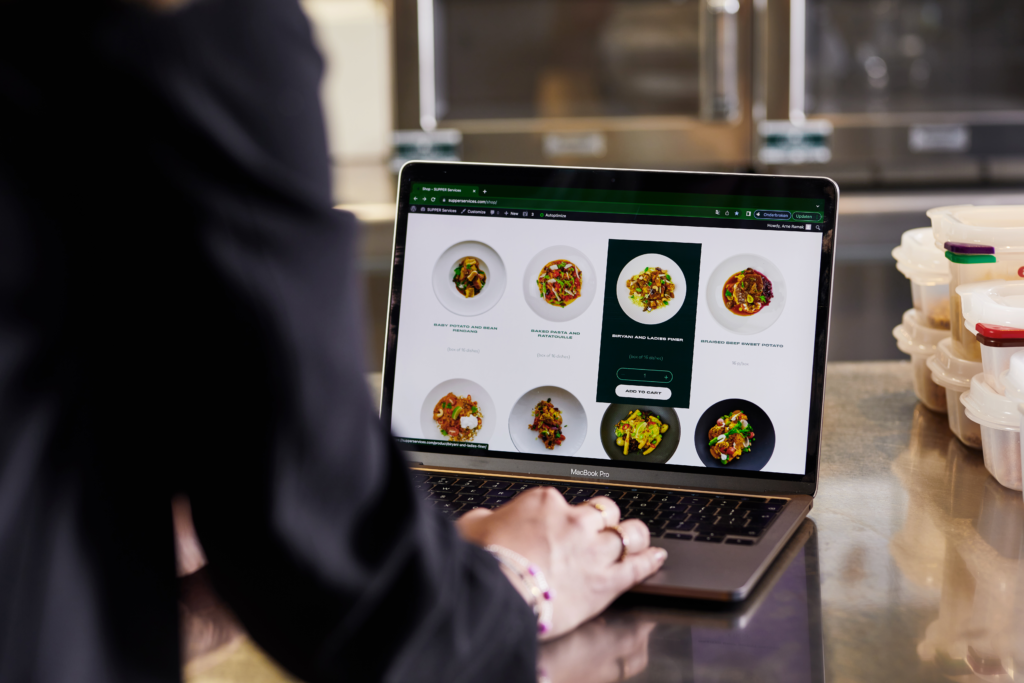
Food waste is a silent margin killer. In hotel F&B, every plate that doesn’t reach a guest eats into cash, time, and trust. When teams are lean and demand is irregular, prep-heavy kitchens create losses you can’t see until stock counts tell the story. This page is about stopping that leak—while raising guest satisfaction and stabilising F&B margins.
If you want the short version first, see how the system works.
The cost of food waste—made visible
Food waste isn’t only about leftovers. It’s over-production, over-portioning, short shelf life, and menu complexity that drives mistakes. Those inputs compound into higher COGS (cost of goods sold), slower service, and inconsistent results. When demand spikes at 23:00 or dips mid-afternoon, traditional mise en place can’t flex without creating waste and labour strain.
With SUPPER you don’t cook on site. You order per portion, receive it ready to finish, then garnish and hand over in ±10 min. That detail changes everything: no batch prep, no guessing, and no “just in case” stock that becomes tomorrow’s bin. It also creates consistent 24/7 service without recruiting additional cooks for late hours.
For a deeper process view, learn about our approach and read answers in the FAQ.
Menu design that protects margin
Menu design is your strongest lever for F&B margins. A compact, well-engineered menu reduces decision friction, speeds service, and stabilises cost. “Menu engineering” simply means structuring dishes to balance popularity, contribution margin, and operational effort.
With SUPPER, recipes are designed to be finished on site—not produced there. Portions are calibrated for taste, yield, and plating speed. Your team focuses on garnishing, assembling, and guest interaction. That keeps quality high and labour predictable while removing the hidden waste from prep and trial-and-error cooking.
Curious how the menu evolves? See new mains added and menu expansion with soups show how we broaden choice without re-introducing complexity. For inspiration and use-cases, insights in our magazine and browse recent product updates.
Right-sized choice, faster decisions
Guests don’t need 40 options at midnight; they need reliable favourites and clear choices. SUPPER menus are built around proven heroes, seasonal additions, and smart pairings that move quickly. Clear naming, concise descriptions, and visual plating cards help staff deliver with confidence. The result: quicker ordering, fewer questions, and steady ticket averages.
Portion control without compromise
Because you order per portion, you control count and timing precisely. That eliminates the classic waste drivers—oversized batches, “end of shift” throw-aways, and inconsistent portions that erode margin and guest trust. You serve the same plate, the same way, all day and night.
For innovation updates, explore explore 520° by SUPPER.
Operations that stay simple, smart, safe
Simple: The workflow is linear—receive, store, finish, garnish, hand over. Stations remain tidy; roles are clear. New staff can be trained quickly because they’re mastering finishing standards, not full production.
Smart: Demand varies by hour and day. Per-portion ordering lets you adapt in real time. Housekeeping orders at 14:30? Lobby peak at 21:15? No problem—scale up or down without re-planning production or adding specialist cooks. Data from your POS and repeat patterns guide par levels and forecasting, not guesswork.
Safe: Process control reduces risk. When cooking happens offsite under controlled conditions, your team finishes and plates to spec. That means fewer variables, fewer errors, and a service that is resilient to staff changes and seasonality.
Service speed that respects guests and staff
Speed isn’t only a guest experience metric; it protects margins by safeguarding throughput. By engineering each step for clarity, teams can comfortably hit ±10 min from order to handover. Faster turns increase revenue opportunity per hour and reduce on-site labour tension—especially during late service or skeleton shifts.
A clean path from pilot to scale
Start with a focused pilot in the bar, lobby, or in-room dining. Assess demand patterns, pick a curated set of dishes, and align plating standards with your brand style. Because there is no on-site cooking, the operational lift is light: small-footprint equipment, clear SOPs, and staff who feel capable from day one.
Once your team is confident, expand to additional outlets or longer dayparts. The same finishing logic applies everywhere, so quality and speed travel with you—without re-engineering your back-of-house each time.
If you want a practical overview before planning, see how the system works.
Measuring what matters: F&B margins
The most reliable path to stronger F&B margins is removing variability from cost and time. Per-portion ordering locks ingredient cost; finishing locks labour minutes; consistent plating locks guest expectations. That stabilises contribution per dish and reduces the “bad surprises” that creep in when teams are stretched.
Two notes as you measure:
- Track actual handover times at the pass.
- Review waste daily by category.
Those two numbers—time and waste—predict guest satisfaction and margin better than any long report.
Why this reduces risk
Risk in hotel F&B often hides in complexity: many SKUs, many prep steps, many skill levels, many suppliers. SUPPER’s system deliberately removes complexity from the venue. You get breadth of offer without building a full kitchen team for every shift. That protects brand consistency, simplifies compliance, and frees managers to focus on service and upsell instead of firefighting production issues.
For background and philosophy, about our approach remains a good starting point.
Next step: taste the difference
Seeing the workflow is useful; tasting it is decisive. Bring your team, try the dishes, and map the service flow to your outlets. We’ll review your demand profile, suggest a menu design that fits your brand, and outline implementation with clear time and training standards.
Ready to move? Book a tasting now and let’s turn food waste into saved margin—without sacrificing service, speed, or quality.
